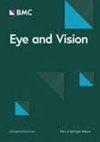角膜圆锥体位置对眼球反应分析仪测量的眼球生物力学参数的影响
IF 4
1区 医学
Q1 OPHTHALMOLOGY
引用次数: 0
摘要
角膜病的特点是角膜的生物力学特性不对称,圆锥体形成区域的病灶薄弱。我们测试了一个假设,即中心测量的生物力学参数在周边圆锥角膜和中心圆锥角膜之间存在差异。我们前瞻性地招募了 50 名角膜炎患者。平均年龄为 38±13 岁。在符合条件的情况下,对双眼的轴向和切线角膜地形图进行分析。角膜中央 3 毫米内的圆锥体被视为中心圆锥体,中央 3 毫米以外的圆锥体被视为周边圆锥体。然后用眼球反应分析仪(ORA)眼压计测量每只眼睛。通过 T 检验比较不同组群之间 ORA 生成的波形参数的差异。共分析了 78 只眼睛。根据轴向地形图,37 只眼睛有中心圆锥,41 只眼睛有周边圆锥。根据切向地形图,53 只眼睛有中心锥体,25 只眼睛有周边锥体。在轴向地形图算法中,周边圆锥体的波得分(WS)明显高于中心圆锥体(组间差异 = 1.27 ± 1.87)。周边圆锥体的第一峰面积 p1area(1047 ± 1346)、第二峰面积 p2area(1130 ± 1478)、第一峰高度 h1(102 ± 147)和第二峰高度 h2(102 ± 127)均明显高于中心圆锥体。角膜滞后(CH)、第一峰宽度 w1 和第二峰宽度 w2 在不同组群之间没有显著差异。切线形图算法的结果与此类似,不同组群之间的 p1 面积(855 ± 1389)、p2 面积(860 ± 1531)、h1(81.7 ± 151)和 h2(92.1 ± 131)差异显著。角膜塑形镜的位置会影响角膜中心负荷下测得的生物力学响应参数。角膜塑形镜向角膜中央输送气泡,因此中央圆锥体的 h1 和 h2 以及 p1area 和 p2area 小于周边圆锥体的事实表明,中央圆锥体的角膜比周边圆锥体的角膜更软或中央顺应性更强,这与病变的位置一致。这一结果证明角膜塑形镜的角膜弱化是局灶性的,与角膜板层定向的局部破坏相一致。本文章由计算机程序翻译,如有差异,请以英文原文为准。
Keratoconus cone location influences ocular biomechanical parameters measured by the Ocular Response Analyzer
Keratoconus is characterized by asymmetry in the biomechanical properties of the cornea, with focal weakness in the area of cone formation. We tested the hypothesis that centrally-measured biomechanical parameters differ between corneas with peripheral cones and corneas with central cones. Fifty participants with keratoconus were prospectively recruited. The mean ± standard deviation age was 38 ± 13 years. Axial and tangential corneal topography were analyzed in both eyes, if eligible. Cones in the central 3 mm of the cornea were considered central, and cones outside the central 3 mm were considered peripheral. Each eye was then measured with the Ocular Response Analyzer (ORA) tonometer. T-tests compared differences in ORA-generated waveform parameters between cohorts. Seventy-eight eyes were analyzed. According to the axial topography maps, 37 eyes had central cones and 41 eyes had peripheral cones. According to the tangential topography maps, 53 eyes had central cones, and 25 eyes had peripheral cones. For the axial-topography algorithm, wave score (WS) was significantly higher in peripheral cones than central cones (inter-cohort difference = 1.27 ± 1.87). Peripheral cones had a significantly higher area of first peak, p1area (1047 ± 1346), area of second peak, p2area (1130 ± 1478), height of first peak, h1 (102 ± 147), and height of second peak, h2 (102 ± 127), than central cones. Corneal hysteresis (CH), width of the first peak, w1, and width of the second peak, w2, did not significantly differ between cohorts. There were similar results for the tangential-topography algorithm, with a significant difference between the cohorts for p1area (855 ± 1389), p2area (860 ± 1531), h1 (81.7 ± 151), and h2 (92.1 ± 131). Cone location affects the biomechanical response parameters measured under central loading of the cornea. The ORA delivers its air puff to the central cornea, so the fact that h1 and h2 and that p1area and p2area were smaller in the central cone cohort than in the peripheral cone cohort suggests that corneas with central cones are softer or more compliant centrally than corneas with peripheral cones, which is consistent with the location of the pathology. This result is evidence that corneal weakening in keratoconus is focal in nature and is consistent with localized disruption of lamellar orientation.
求助全文
通过发布文献求助,成功后即可免费获取论文全文。
去求助
来源期刊

Eye and Vision
OPHTHALMOLOGY-
CiteScore
8.60
自引率
2.40%
发文量
89
审稿时长
15 weeks
期刊介绍:
Eye and Vision is an open access, peer-reviewed journal for ophthalmologists and visual science specialists. It welcomes research articles, reviews, methodologies, commentaries, case reports, perspectives and short reports encompassing all aspects of eye and vision. Topics of interest include but are not limited to: current developments of theoretical, experimental and clinical investigations in ophthalmology, optometry and vision science which focus on novel and high-impact findings on central issues pertaining to biology, pathophysiology and etiology of eye diseases as well as advances in diagnostic techniques, surgical treatment, instrument updates, the latest drug findings, results of clinical trials and research findings. It aims to provide ophthalmologists and visual science specialists with the latest developments in theoretical, experimental and clinical investigations in eye and vision.
 求助内容:
求助内容: 应助结果提醒方式:
应助结果提醒方式:


